Although asparagus and green beans have a lot of differences, they are both tasty vegetables with health-boosting vitamins and minerals that we should all eat more of. That’s about it, though! Let’s take a closer look at the many aspects that hold asparagus vs. green beans apart.
Comparing Asparagus vs. Green Beans
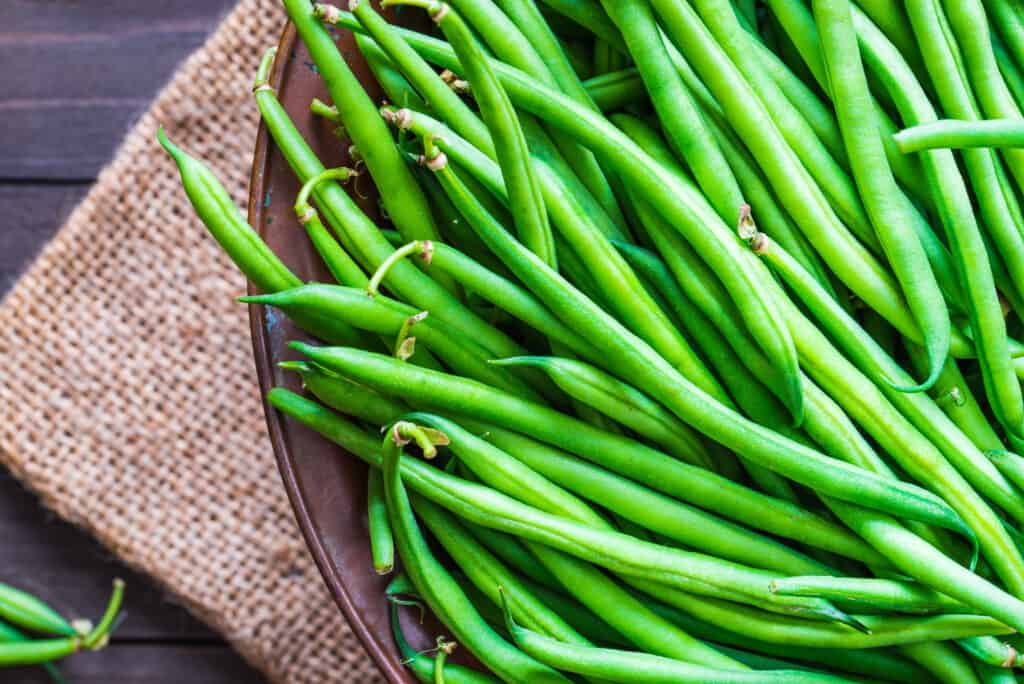
There are 130 cultivars of the common bean Phaseolus vulgaris, and in the States, they’re often called French beans, string beans, or snap beans.
©leonori/Shutterstock.com
| Asparagus | Green Beans | |
|---|---|---|
| Scientific name | Asparagus officinalis | Phaseolus vulgaris |
| Hardiness zone | 4 through 9 | 2 through 11 |
| Perennial or annual | Perennial | Annual |
| Years to harvest | 3 from planting | Same year |
| Foliage | Green fluffy ferns | Green trifoliate hearts and ovals |
| Flowers | Green-white to yellow | Red, white, or purple |
What Is Asparagus?
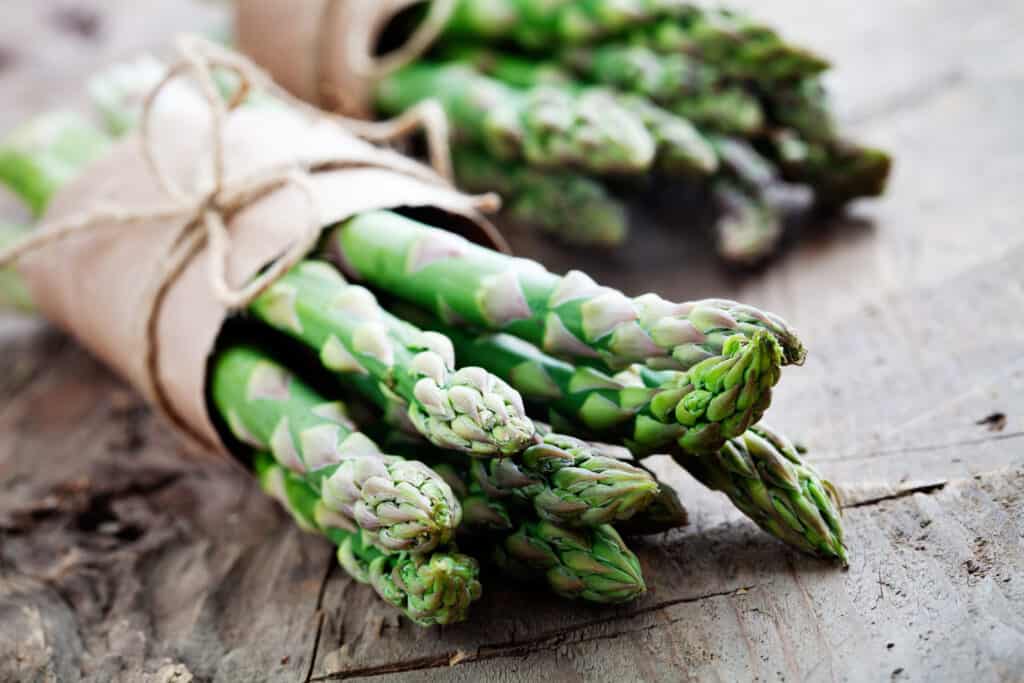
Asparagus is perennial, which means it grows back each year.
©Kati Finell/Shutterstock.com
Asparagus officinalis is a perennial flowering plant in the asparagus genus. It’s commonly called sparrow grass, and there are up to 300 species.
Asparagus is perennial, which means it grows back each year. It’s grown in soil, and its crown pushes up fresh new tips that are quickly harvested because when the buds start to appear, the stems turn woody.
It’s usually green, but there is an Italian purple version that’s higher in sugar, and white asparagus, which is blanched green asparagus. To blanch it, the shoots are covered with soil to prevent photosynthesis.
Asparagus is tasty, but it has rather unpleasant effects on urine! It’s because it contains volatile sulfur compounds that are released when it’s digested. That said, it’s an excellent plant for heath. This article from Pharmacognosy Reviews suggests asparagus is an antioxidant and an immuno-stimulant, so maybe we can forgive the effect on our bladders!
What Are Green Beans?
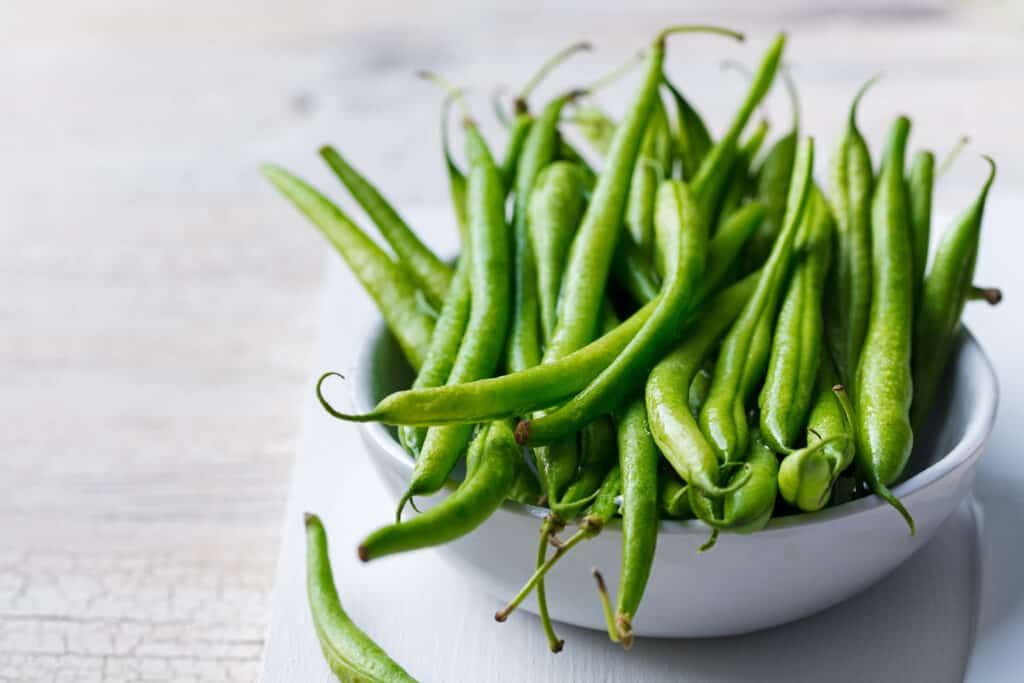
Beans plants grow above ground with roots anchored in the soil.
©Anna_Pustynnikova/Shutterstock.com
Green beans are very different from asparagus because they are the fruit of the bean plant. Beans plants grow above ground with roots anchored in the soil. There are two main types, vine beans that grow on long twisting stems up to eight feet tall and bush beans that only reach two feet.
There are 130 cultivars of the common bean Phaseolus vulgaris, and in the States, they’re often called French beans, string beans, or snap beans. What makes them different from other beans, such as runner beans, for example, is they’re eaten whole, beans and surrounding pod all in one.
Key Differences Between Asparagus vs. Green Beans
The key differences between Asparagus and Green Beans are origins, flowers, foliage, planting zones, and seeds.
Asparagus vs. Green Beans: Origins
Asparagus is native to the eastern Mediterranean, and its name is Persian asparag, which means sprout or shoot. This tasty veg has been cultivated and eaten for thousands of years. The ancient Roman author Cato the Elder described how to grow asparagus in his treatise “On Farming.” Some scholars think the Greeks and Romans took asparagus with them when they conquered vast areas of the world, and when Europeans arrived in the Americas, they took tasty asparagus with them.
Green beans originate from Central and South America and have been cultivated for thousands of years. The ancient Mayans grew and ate many types of beans, and they’ve spread across the world, becoming a staple part of our diet. It’s thought colonizing Spaniards took green beans back to Europe in the 1600s.
Asparagus vs. Green Beans: Foliage
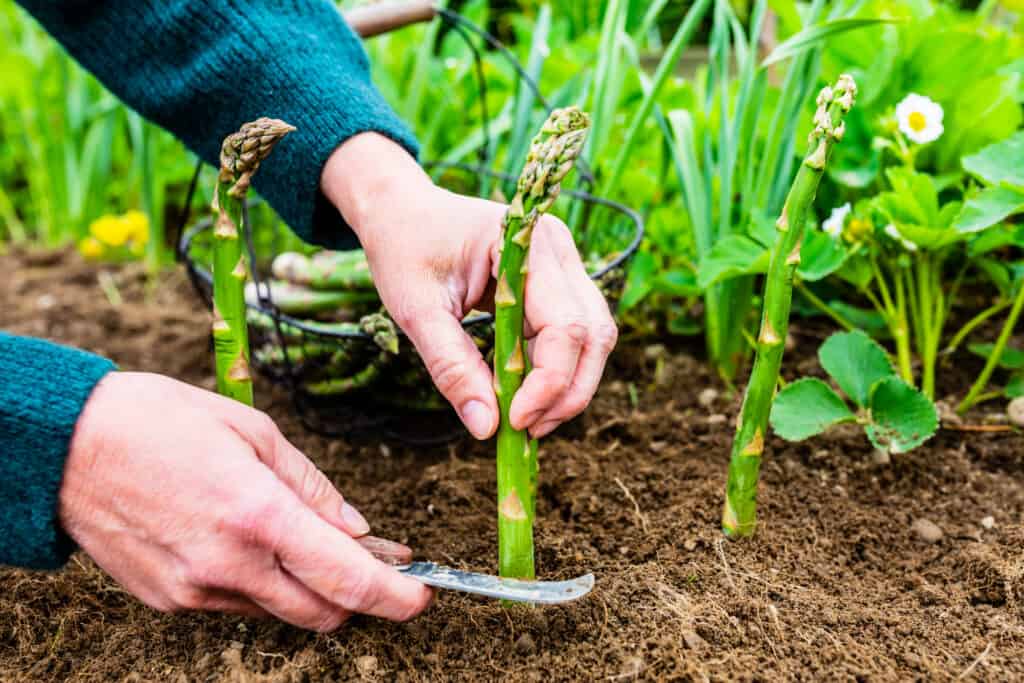
Asparagus is a delicate-looking fluffy plant, much like carrot and parsnip foliage.
©iMarzi/Shutterstock.com
The foliage of asparagus is unmistakable. It has a thick stem that grows to 60 inches (150 centimeters) tall with many branches of feathery fern-like foliage. It’s a delicate-looking fluffy plant, much like carrot and parsnip foliage.
In contrast, green bean foliage is pale green with heart-shaped and veined trifoliate leaves. The leaves can reach six to eight inches in length and cover vines up eight feet tall. Green bean vines and foliage need trellis or bamboo support to grow vertically unless it’s a dwarf cultivar.
Green Beans vs. Asparagus: Flowers
Green bean flowers are very attractive to pollinators, and there are various colors, including red, orange, white, and purple, depending on the cultivar. They look a lot like pea or salvia flowers.
Asparagus flowers are green-white to yellow and bell-shaped, so they look very different, but bees also love their blooms. Interestingly, asparagus plants are either male or female, and the female plants produce seeds from their flowers.
Green Beans Seeds vs. Asparagus Seeds
Asparagus seeds are ready to harvest when the berry-like seed pods turn red. The seeds are small black ovals but big enough to handle. Green bean seeds are contained in the long pods that develop on the vine. We usually eat them along with the pod, but if they’re left to mature, they harden into large white, pink, or purple beans depending on the species.
Green bean seeds are some of the easiest vegetable seeds to germinate, so they’re great for kids wanting to get their little hands in the soil. Just wait until the frosts have passed before planting them outside.
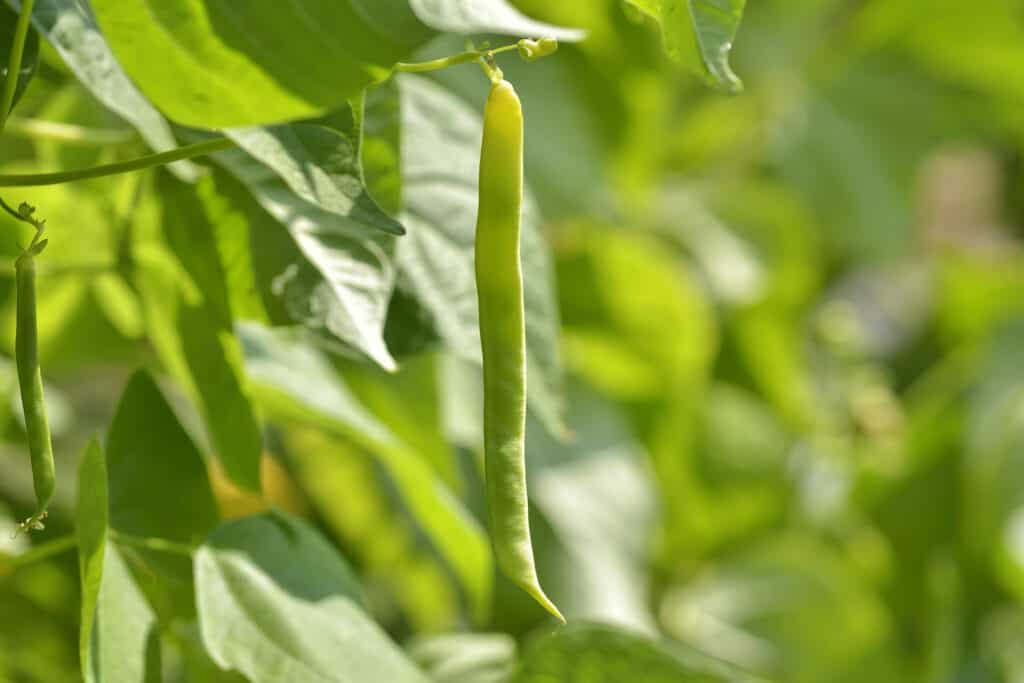
Green bean seeds are contained in the long pods that develop on the vine.
©iStock.com/Remus86
Asparagus vs. Green Beans: Planting Zones
Green beans are annual vines germinating and dying off in one year. They’re easy to grow and produce lots of tasty beans from zone 2 through 11. It’s one of the reasons green beans are such a big part of human diets across the world. Asparagus is also a hardy plant. It’s perennial and dies back to its crown yearly, but asparagus grows in zones 4 through 9.
Can Dogs Eat Green Beans and Asparagus?

Asparagus shoots are not toxic, but if pets chew the berries and foliage, it can cause gastric upsets.
©MasterQ/Shutterstock.com
Dogs can eat green beans as part of a regular diet, and the ASPCA recommend them as a tasty slimming snack that dogs (and cats) enjoy. Asparagus shoots are not toxic either, but if pets chew the berries and foliage, it can cause gastric upsets.
Which Is Best Green Beans or Asparagus?
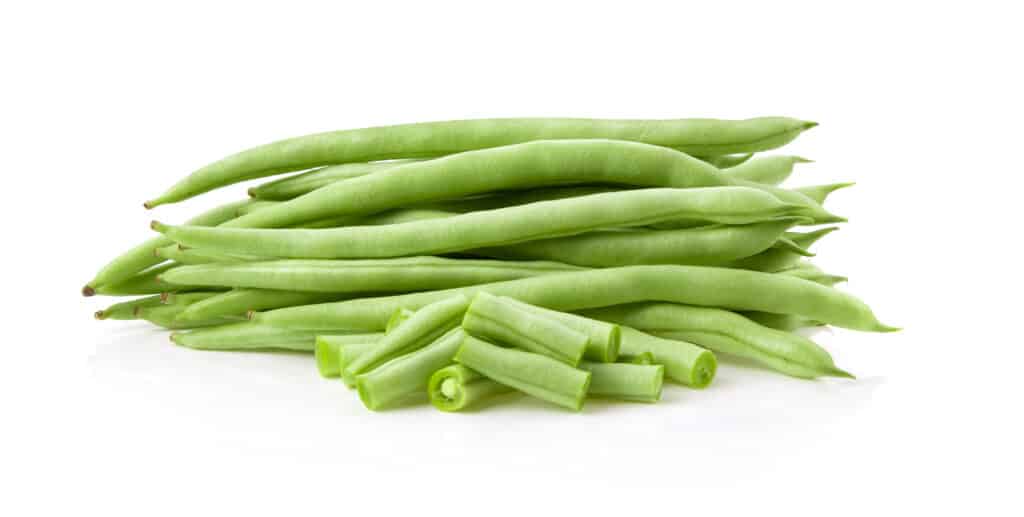
Greens beans are an annual vine or bush that are very easy to grow.
©pukao/Shutterstock.com
It’s difficult to choose between green beans and asparagus because they’re both tasty and have great nutritional value.
Greens beans are an annual vine or bush that are very easy to grow. Crops can be harvested the same year the seeds are sown because they grow so quickly. Asparagus takes longer, and it’s best not to harvest it for three years, but asparagus is pricey in the store, and the crowns are perennial, so once it’s planted, it won’t need to be replaced.
We’ll call it a draw!
What About Asparagus Beans?
It’s worth mentioning asparagus beans (Vigna unguiculata subsp. Sesquipedalis). They’re better known as yard-long beans due to their extreme 1.5 feet length!
Asparagus beans are a variety of cowpea, so they’re neither asparagus nor green beans, despite their name.
Up Next
The photo featured at the top of this post is ©
Sources
- American Society for the Prevention of Cruelty to Animals, Available here: https://www.aspca.org/news/healthy-safe-snacks-help-your-pet-slim-down#:~:text=Green%20beans%20are%20very%20low,a%20great%20weight%20loss%20snack.
- The Royal Horticultural Society, Available here: https://www.rhs.org.uk/vegetables/french-beans/grow-your-own
- Soil and Health Library, Available here: https://soilandhealth.org/wp-content/uploads/01aglibrary/010121cato/catofarmtext.htm
- Science Direct, Available here: https://www.sciencedirect.com/science/article/pii/B9780128127803000179
Thank you for reading! Have some feedback for us? Contact the AZ Animals editorial team.






